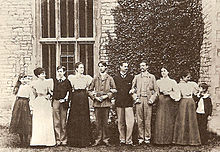- Oliver Strachey
-
Oliver Strachey (3 November 1874 – 14 May 1960), a British civil servant in the Foreign Office was a cryptographer from World War I to World War II.
He was a son of Lt-Gen Sir Richard Strachey and Lady (Jane) Strachey, and a brother of the writer Lytton Strachey. He was educated at Eton College and attended Balliol College, Oxford for one term (Hilary 1893). According to Who was Who he was in the Foreign Office, and engaged in work on East Indian Railway and historical research. He co-authored with his wife Ray a work on Keigwin’s Rebellion (1683–84), an episode in the history of Bombay; it was published in 1916.
His first marriage to Ruby Julia Mayer produced one daughter, Julia Strachey, and ended in divorce. In 1911, he married Rachel Conn (Ray) Costelloe (1887–1940). They had two children Christopher and Barbara. Christopher Strachey later became a pioneer in the development of computers and computer languages.
In World War I, he was in British Military (Army) Intelligence, MI1. Between the wars, he was in the Government Code and Cypher School. In 1934, Strachey and Hugh Foss broke the Japanese naval attaché machine cipher.
In World War II, he was at Bletchley Park. He headed the ISOS section deciphering various messages on the Abwehr network involved with turned German agents (part of the Double Cross system), with the first decrypt issued on 14 April 1940. Initially codenamed Pear, the decrypts became known as ISOS, standing either for Illicit or Intelligence Services (Oliver Strachey). He was replaced as head of ISOS by Denys Page in early 1942.
In January 1942, Strachey went to Ottawa, Canada, where he was chief cryptographer in the Examination Unit, where he remained until July. This ambiguously named, top secret cypher department was the Canadian version of Bletchley Park. His predecessor at the Unit was the notorious Herbert Osborne Yardley, who had written a sensational expose of American and British cryptography in World War I, "The American Black Chamber" (1931). Yardley's contract was not renewed under pressure from Washington. Strachey refused to go to Ottawa until Yardley had left the city.
Strachey brought with him from England keys to high-level French Vichy and Japanese diplomatic codes, which initiated close cooperation with Washington and London. Although he did not speak or read Japanese, he helped break the Japanese encryption, which was very complex, since it used variations of kanji, hiragana, and romanization. At 67, he "was a man whose best work has been done."
His recreations were music and reading. He was awarded a CBE in 1943.
References
- Who was Who, 1951–1960.
- Action this Day edited by Michael Smith & Ralph Erskine (2001, Bantam London). ISBN 0593049101.
- A History of the Examination Unit 1941-1945," edited by G. deB. Robinson, the official history written in 1945, is in Library and Archives Canada.
- Crytptographic Innocence: The Origin of Signals Intelligence in Canada in the Second World War," by Wesley Wark, in Journal of Contemporary History, October 1987.
Categories:- 1874 births
- 1960 deaths
- Old Etonians
- Alumni of Balliol College, Oxford
- British cryptographers
- Pre-computer cryptographers
- People associated with Bletchley Park
Wikimedia Foundation. 2010.

